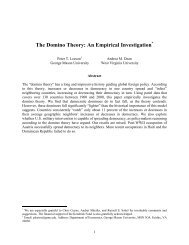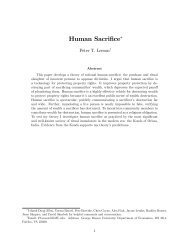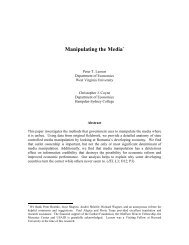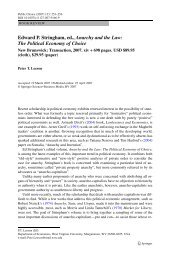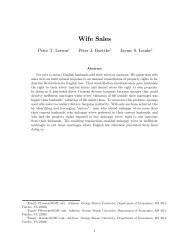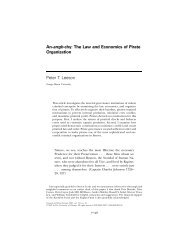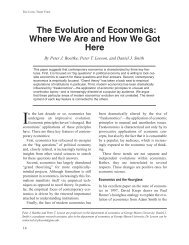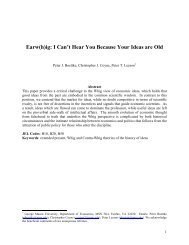The Democratic Domino Theory: An Empirical Investigation
The Democratic Domino Theory: An Empirical Investigation
The Democratic Domino Theory: An Empirical Investigation
Create successful ePaper yourself
Turn your PDF publications into a flip-book with our unique Google optimized e-Paper software.
DEMOCRATIC DOMINO THEORY 537<br />
spatial weight matrix requires values for all countries in<br />
all years in the sample.<br />
Our data on democracy come from the Polity<br />
IV project (2004), which measures countries’ levels of<br />
democracy annually, beginning with 1850. This measure<br />
ranges from −10, or “total autocracy,” to +10, or “total<br />
democracy.” To measure the extent of democracy across<br />
countries, the Polity IV data consider the presence of<br />
political institutions and procedures through which citizens<br />
can express effective preferences about alternative<br />
policies and leaders and the existence of institutionalized<br />
constraints on the executive’s exercise of power. <strong>The</strong> resulting<br />
democracy measure captures the competitiveness<br />
of political participation, openness and competitiveness<br />
of executive recruitment, and constraints on the chief<br />
executive in each country. Polity IV has constructed a<br />
variable to measure these factors specifically for the purpose<br />
of time-series analysis, which makes each country’s<br />
democracy score comparable over time. We use this measure,<br />
called Polity 2, for our analysis.<br />
Our econometric analysis uses spatial methods,<br />
which are the most natural and effective way to reliably<br />
estimate the spread of democracy between geographic<br />
neighbors. Unlike Ordinary Least Squares, which produce<br />
biased estimates in the face of spatial correlation,<br />
spatial methods are designed specifically to identify and<br />
measure spatial dependence. This makes spatial methods<br />
ideally suited to investigate the democratic domino theory<br />
since, as Danilovic points out, the domino theory is<br />
“premised on this understanding of international events<br />
as spatially interdependent” (2001, 344). If there is strong<br />
spatial dependence between countries’ changes in democracy<br />
as the democratic domino theory contends, spatial<br />
methods will identify it and efficiently estimate this dependence.<br />
We use two spatial models for this purpose,<br />
a spatial autoregressive model (SAR) and a spatial error<br />
model (SEM). Each searches for spatial dependence in a<br />
different way.<br />
For readers unfamiliar with spatial methods it is useful<br />
to think of the SAR model as analogous to an autoregressive<br />
(AR) time-series model but with lags over<br />
geographic distances rather than time. So, for a country<br />
i, onespatiallagreferstoallofi’s contiguous geographic<br />
neighbors, two spatial lags refers to contiguous<br />
geographic neighbors of i’s neighbors (i’s neighbors that<br />
are two countries away), and so on.<br />
<strong>The</strong> SAR model specifies each country’s dependent<br />
variable, in our case changes in democracy, as a function<br />
of the weighted value of the changes in democracy in its<br />
neighbors. It models how explained changes in democracy<br />
spill over onto geographic neighbors. <strong>The</strong> SAR model<br />
allows potential democracy spillovers to flow multidirectionally<br />
rather than unidirectionally as it would in an AR<br />
time-series model. This is important since we are interestedinhowchangesindemocracymayflowintoandout<br />
of multiple countries, influencing the extent of democracy<br />
in each nation.<br />
<strong>The</strong> SEM model is analogous to the moving average<br />
(MA) time-series model for contiguous geographic<br />
neighbors, which includes a spatially correlated error<br />
structure. <strong>The</strong> SEM model specifies each country’s error<br />
term, in our case for changes in democracy, as a function<br />
of the weighted value of the changes-in-democracy error<br />
term of its geographic neighbors. It models how unexplained<br />
changes in democracy spill over onto geographic<br />
neighbors. Like the SAR model, the SEM model allows<br />
for multidirectional flows of influence rather than unidirectional<br />
flows as it would in an MA time-series model.<br />
Our SAR model takes the form:<br />
D t = + WD t + D t−5 + X + t<br />
where D t is an N × 1 vector that measures countries’<br />
changes in democracy between year t and year t − 4.<br />
We consider countries’ changes in democracy over fouryear<br />
periods to allow sufficient time for changes in countries’<br />
democracy to occur. D t −5 is an N × 1vectorthat<br />
measures countries’ lagged levels of democracy—i.e., the<br />
level of democracy that prevailed in each country the year<br />
immediately preceding the four-year period over which<br />
countries’ changes in democracy are calculated. X is an<br />
N × K matrix of exogenous variables, and t is an N × 1<br />
vector of IID random errors. 4<br />
We include countries’ lagged levels of democracy<br />
in order to control for as many factors as possible besides<br />
democratic contagion that might affect changes in<br />
democracy in its geographic neighbors. This variable accountsforthefactthatgeographicneighborsoftensharea<br />
similar colonial origin, legal origin, form of government,<br />
degree of ethnolinguistic fractionalization, and other such<br />
factors that tend to persist over time. It controls for any<br />
features of countries that contribute to their changes in<br />
democracy which were present the year before the period<br />
of tabulated change. <strong>The</strong> lagged democracy variable is also<br />
useful because it allows us to determine whether there is<br />
“democratic convergence” across countries. If countries<br />
with lower levels of democracy in the previous period<br />
grow faster in terms of democracy the following period,<br />
will be negative, suggesting democratic convergence. If<br />
countries with lower levels of democracy in the previous<br />
4 To estimate our SAR model we use the spatial estimation program<br />
for MATLAB from Jim LeSage’s “Econometrics Toolbox,” publicly<br />
available at http://www.spatial-econometrics.com/. We use<br />
the “sar” command, which implements a maximum likelihood<br />
estimation.



